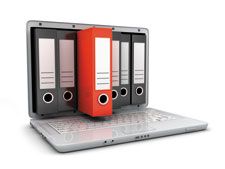The Transition to Electronic Records
A four-stage process to successfully make the switch from paper to electronic batch records is presented.
VladFree/shutterstock.com

Challenges associated with using paper-based processes to manage pharmaceutical manufacturing are leading pharma companies to adopt technology solutions. The following is a practical guide to migrating from paper-based records to electronic batch records (EBRs) in pharmaceutical manufacturing. The author considers factors that are driving the adoption of technology and outlines a four-stage process to successfully make the switch.
A changing landscape
The transition from paper-based processes to the use of technology to manage operations is becoming more and more common within the pharmaceutical manufacturing industry. The increased adoption of manufacturing execution system (MES) technology can be attributed to the limitations and challenges associated with using paper-based systems. Paper-based recording is a lengthy process. Data needs to be located manually and transcribed into a system before being analyzed; in some cases, the information is no longer relevant by the time it is recorded.
Lack of information visibility can cause problems in planning production activities. Paper-based systems can also lead to documentation errors, which affect regulatory compliance and can be costly to the business, both in time and in money.
With paper-based systems, data are not recorded and reported in real-time, which can increase product waste and the time spent investigating deviations. Potential issues are also not identified and recorded as they happen, meaning a delay in resolving these issues.
The time lag between using materials and updating the system can also cause issues as the inventory is not always up-to-date. Operations teams may have to manually count items due to inaccurate recording or late reporting of important information such as materials issues and materials receipts transactions. Furthermore, paper-based systems can delay production if, for example, production operators are left waiting for materials and quality approvals.
MES technology can help eradicate many of these issues. Electronic data capture allows for real-time visibility of information, which saves time at all stages of the process.
Regulatory compliance is also dramatically increased as EBRs raise any issues as they occur, so that they can be dealt with promptly and effectively. MES technology helps ensure that information can flow smoothly around a manufacturing plant. This flow produces quality products and ensures ‘right-first-time’ production.
To ensure smooth integration of this technology, there are four key stages to success. The migration from paper to electronic reporting may seem daunting, but there are steps that can be taken to simplify the process.
Stage one: Establish a business case
The transition to an electronic system affects all aspects of production, from planning and execution, through to control, monitoring, and documentation. The deployment of the technology can disrupt the organization in critical ways, meaning that if this is not handled properly there can be negative consequences. One must think ahead to how the new systems and processes may affect staffing, training, and organizational roles and plan how to make necessary changes.
The first step is to have a champion within the organization to take a lead and help socialize the new project to its stakeholders. This person will drive the process to develop the business case in the beginning but will also take responsibility for ensuing that each future project stage is handled properly.
A valid business case will help convince all stakeholders (e.g., finance, operations, quality, IT, engineering) that the investment is worthwhile and will bring the desired benefits to the organization, such as improving documentation compliance or reducing operational costs.
Return on investment (ROI), which helps to quantify the value of the business case in a meaningful way, should also be determined. In the author’s experience, cloud-based systems, for example, prove to be cost effective as they can be scaled up or down to meet customer requirements, typically generating ROI in 12-18 months. Furthermore, MES technology has been proven to improve productivity by 25% in some cases.
Although EBR is the typical functionality used to justify investments in MES systems, their broad functional coverage makes them quite attractive. European regulatory agencies, for example, require the submission of a Summary of Product Characteristics before any medicinal product is authorized for marketing. The data collection and reporting capabilities of MES make it easy to achieve this. The savings achieved in that area become one more component of building the business case for the entire solution. The functionality to track overall equipment effectiveness (OEE) is another example where a small increase in investment can lead to significant returns.
Finally, improving process compliance is another factor when companies are establishing their business case. MES technology can be used to issue electronic work instructions and track process performance.
Stage two: Plan your course of action
The next stage is to review best practices for planning and identify the correct course of action for implementation. Once the decision to move to using MES technology has been made, the key is to approach the project in a well-informed and well-planned manner.
To ensure success, goals should be put in place and a project charter developed. This will allow all parties involved in the MES integration process to fully understand the project objectives. Key performance indicators (KPI) should also be established to allow for specific measurements and establish accountability to the entire team.
For the new system to be effectively integrated, the entire organization needs to work together. An effective way to do this is through a concept of operations (COO), which establishes production policies. This document outlines how daily operations will be managed and by whom, identifies any benefit that will be gained from the migration to an MES system, and defines the role of each organizational department.
With the COO and project charter in place, all key stakeholders must be introduced into the process. Involving management, planning, production, quality, and IT staff will ensure that they are prepared for the upcoming changes. This process allows for the communication of the benefits to the organization as well as explaining how the changes will shape their roles. There are many ways to do this, for example through training and internal communications. Employees need to fully understand their new role and responsibilities to allow them to focus on making products ‘right first time’.
It is within this planning stage that it is important to also create a detailed IT strategy. This strategy must consider how the new system will integrate with any peripheral systems, including automation systems, so that communication flows are minimized.
This cohesive approach to planning is key to eliminating any potential negative side effects and reducing the project implementation timeline. There will be some unavoidable disruption when implementing new systems, but with effective planning many issues can be avoided.
Stage three: Implementation
The next step is to implement the MES, and the success of this will depend on the project plan and IT strategy. An analysis phase is advised here, as this will allow existing business processes to be converted into workflows and the necessary software functions and configurations to be established. At this stage, interfaces with other systems can be developed against formal specifications.
After the configuration process, the software must be qualified in accordance with the International Society for Pharmaceutical Engineering (ISPE) GAMP-5 validation model, an established industry standard (1). This process includes factory acceptance testing (FAT), installation qualification (IQ), and site acceptance testing (SAT). Depending on the type of software configuration, the level of qualification documentation and cooperation between the organization and vendor will vary. This is typically described in the master validation plan for the project.
Once the MES solution is available, it needs to be configured to migrate paper records to electronic format. This task is a significant opportunity to harmonize business processes and establish corporate standards, particularly if the system is expected to be deployed in multiple locations.
Next, the organization must validate the solution against its user requirements and business use. This is the stage at which the functionality of the software is tested, known as the operational qualification (OQ).
Standard operating procedures (SOP) must be updated to allow for the fact that paper systems are no longer being used. Here, the company must decide what information should be included in its SOPs versus what should be included in a batch record. For example, the EBR may include GMP and patient-related data, while SOPs may be more suited to information for operators (i.e., equipment assembly instructions).
The final stage of implementation is for training to be delivered to operators. All those that will be affected by the new system (i.e., electronic record designers, quality supervisors, production operators, and IT administrators) must be fully educated on their new role and responsibilities.
As can be seen, there are many facets to designing and configuring an EBR solution; the more planning you can do beforehand, the better.
Stage four: Launch and evaluation
Before the project can go live, master and inventory data need to be loaded into the production system. This loading may involve a fair amount of preparation to clean up master data and start the MES system with accurate inventory information. Any data loading tool that is used will need to be validated ahead of time. It is important to remember that there may initially be lower production output when a system first becomes operational. The organization may take some time to adapt to the new ways of working and employees will be settling into their changed roles. Taking this into account, consider increasing production in the run up to the changeover to counteract the diminished performance during the learning period. It is also essential to manage any customer expectations during this time.
Monitoring that the MES is performing as expected is important at this stage to create accountability and a true success story. This is the time when KPIs defined during the early planning phase of the project are measured and published to the organization.
Software upgrades are the next step to consider now that the system is live. Its lifecycle has only just started so one may want to take advantage of new features or functionality that may be introduced. Vendors must be very clear on the process that is required to upgrade the MES. It is important to determine the impact of any upgrade upon the exiting solution and the dependence on the vendor to perform the upgrade. Ideally, one should require as little support from the vendor as possible.
Consider allowing the vendor to access data remotely so that problems or investigations can be handled quickly and efficiently. An online ticket submission system is now the preferred option to obtain system support.
Conclusion
Before making the transition from paper-based reporting to EBRs with the implementation of an MES, it is important to think about the impact that the technology will have across the entire organization. Changes will affect all aspects of the company’s operations (e.g., change management, operations, quality, IT, engineering, training, validation, SOPs), as well as having an impact on its people. The success of the project will rely on a holistic approach to planning, with potential issues considered ahead of time.
Perhaps surprisingly, the actual implementation of an MES system represents approximately 25% of the total project costs. The remainder of the project consists of:
- IT infrastructure (10%)
- Process engineering and paper batch record migration (30%)
- Change management (communication, training, SOPs) (10%)
- Validation activities (25%).
Each of the stages outlined here will help to efficiently and successfully migrate from paper-based records to a more effective MES system, improving compliance and ensuring ‘right-first-time’ production.
Reference
1. ISPE, Gamp 5: Compliant GxP Computerized Systems (ISPE, February 2008).
Article Details
Pharmaceutical Technology
Vol. 41, No. 1
January 2017
Pages: 54-56
Citation
When referring to this article, please cite it as C. Fortunel, "The Transition to Electronic Records," Pharmaceutical Technology 41 (1) January 2017.
